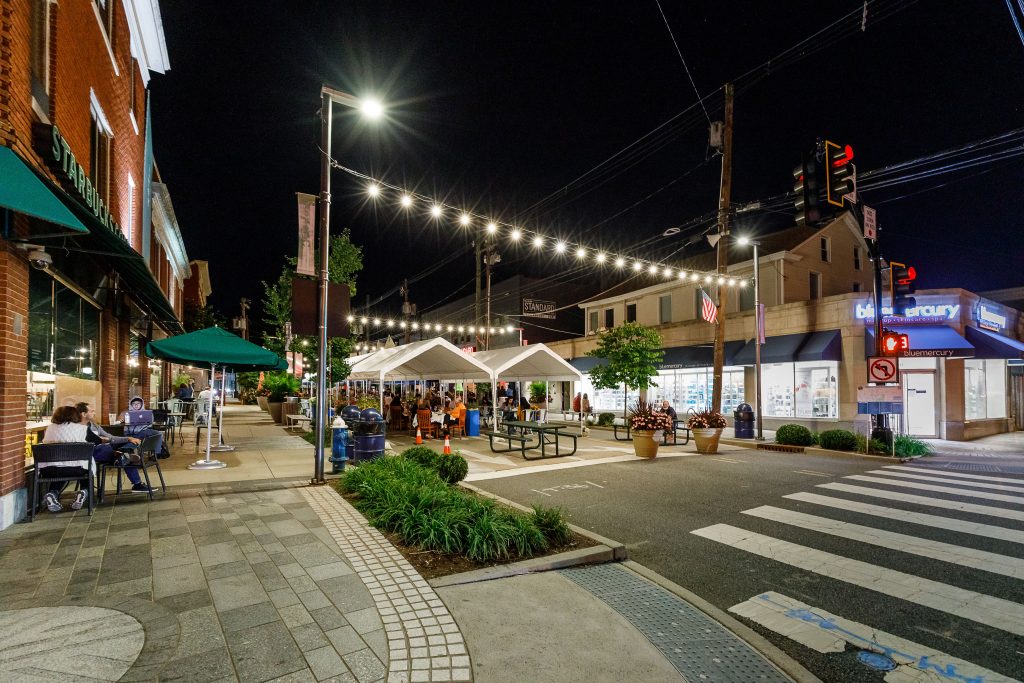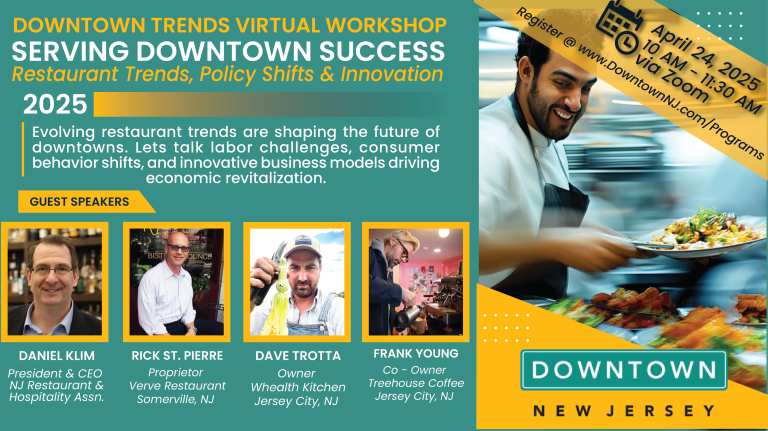The Importance of Flexible Streets
By Dave Lustberg, LLA
CEO and Managing Principal, Arterial
February 4, 2021
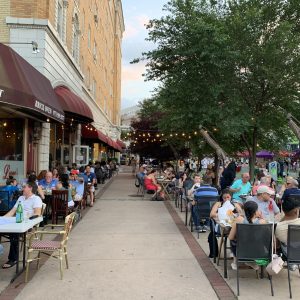
Wide sidewalks at Montclair’s South Park Street
It is during challenging times that we get to rethink how we can work together to thrive and stay resilient. Almost a year ago, the world halted and changed overnight because of the COVID-19 pandemic. During that time, many communities learned to adapt and use whatever tools they had at their disposal to help their residents and businesses stay afloat. For many cities and towns, the secret to their success is something we have been advocating for long before “streeteries” and pop-up plazas were a thing: Flexible Streets.
Flexible Streets are streets designed to adapt to the varying conditions and roles that a street plays in our communities. When planning flexible streets, we recognize that the role a particular street takes on may change depending on the day, time of year, season, or many other different factors, in this case, a pandemic. The implementation of Flexible Streets in downtowns has helped many cities and townships in New Jersey to adapt quickly, offering community members an enjoyable experience while also providing local businesses the opportunity to stay afloat and bring life back to their downtown. We found that flexibility in three key elements of the street have helped communities thrive during Covid-19:
- Having the right balance of street space to accommodate different users/uses
- Expanding the sidewalk space at key locations
- Allowing users to share the road
Adapting our Streets During the Pandemic
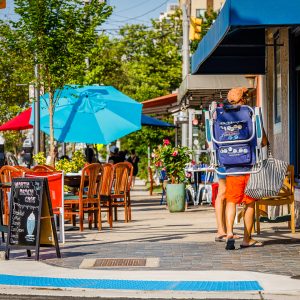
Ventnor City has wide sidewalks that allow tourist to enjoy the street at their own pace
After weeks of confinement, many of us had the urge to go outside, with our masks on, and explore our towns. However, many of us were concerned with our ability to maintain proper social distancing while walking on the street. Will I have enough room to pass someone while also keeping 6-feet away? Well, not if you have wide travel lanes and narrow sidewalks. Many cities and towns quickly realized that their sidewalks were too narrow and scrambled to temporarily adjust travel lanes or eliminate parking in an attempt to give pedestrians or restaurants more space. While this quick adaptation helped, it required many compromises to the pedestrian experience, created accessibility challenges and required a lot of red tape. Cities and towns with properly balanced streets and/or the ability to easily widen their sidewalks were able to easily adjust to this new situation.
In 2009 Montclair, NJ, took the step to transform South Park Street from a car-centric street with little pedestrian space into a pedestrian-centric flexible street. South Park Street’s 25-foot promenade-style sidewalk allowed people to explore the downtown comfortably, window shop and stop to chat with neighbors all while maintaining proper social distancing. Restaurants could easily shift their inside seating to outside and continue business as usual (almost). But restaurateurs were not the only ones who benefited from wide sidewalks. Many local shops also saw the dividends of ample space for pedestrians as foot traffic increased, with more people being drawn to areas with considerable space for casual walks as well as window-shopping in the downtown.
Wide sidewalks are especially important in locations which attract a lot of tourists. Last year, the City of Ventnor, NJ had just inaugurated their new Complete Street improvements on Atlantic Avenue. As a beach town, Ventnor sees an influx of people during the summer months. Tourists tend to walk a little more slowly, window shopping and exploring as they go. Atlantic Avenue is a main street very close to the beach, which means that it gets a lot of activity during the summer. When businesses were allowed to open again right before the summer, people found that the new improvements in Ventnor helped local restaurants expand their seating options on the wide sidewalk without interrupting the flow of pedestrian traffic.
Street corners are the gathering spaces in our downtown.
This is where people naturally congregate – and it is important to provide ample space for them to do so. One way to enhance street corners is to include curb extensions. Corner curb extensions expand the space at the corners while also reducing the street’s crossing distances. Win-win!
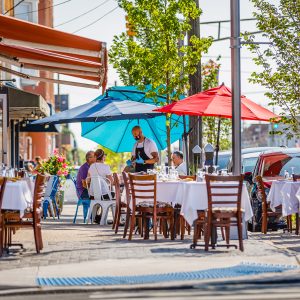
After restrictions were lift, Ventnor restaurants used the curb extensions to accommodate their patrons
Mid-block curb extensions are also a great way to provide additional sidewalk space. Many of us know the temporary version: parklets. These quick, use-a-parking-spot solutions are great for quick-fixes and to test ideas – but oftentimes they are cost prohibitive for restaurants, are not guaranteed and require a lot of red tape. When possible, we promote more permanent interventions.
Back when Ventnor was just starting to conceptualize the improvements on Atlantic Avenue, they were faced with two options for their street design. The first option limited the curb extensions to the street corners. The second option traded a parking space or two for longer curb extensions that would allow restaurants to provide additional outdoor dining. If they were to lose one parking space they could add four to five more tables outside. At first the city was hesitant and assumed that business owners would prefer the parking space – but, spoiler alert, it was the opposite. Restaurant owners chose the additional tables – and they were lucky they did! When New Jersey lifted the quarantine restrictions and allowed restaurants to operate with outdoor dining, it was just in time for Ventnor to capitalize on their summer peak season. Restaurants and businesses thrived and we were even told that three new restaurants opened in this area during COVID-19!
Sharing The Road (for real)
‘Share the road’ took on a whole new meaning during the pandemic. We saw the emergence of “Streeteries” throughout the country where roads were closed partially or entirely to allow restaurants and other programming to “share” the street space. Communities whose streets were designed to be flexible had been sharing the street even pre-COVID. So for them, this was an easy shift!
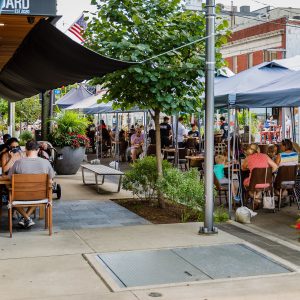
Millburn closed their main street on Downtown to open it as a public space.
In 2017, Millburn, NJ took significant steps to improve its downtown streets and make them more adaptable and flexible. Many of these features proved to be invaluable during the pandemic.
The wide sidewalks and unique “flexible parking” allowed the town to quickly and easily trade parking for wide sidewalks. They could do so by simply moving a bollard without the worry of dealing with accessibility issues, permitting or other red tape. This provided ample space for pedestrians and restaurants while allowing for proper social distancing. But perhaps the biggest impact was the ability to close Main Street to cars and open it as a public space. The street was designed with many features that allowed this to be possible.
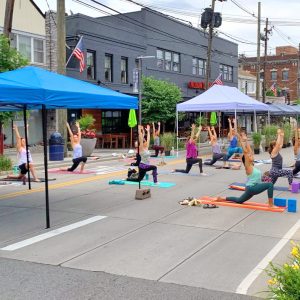
The flat concrete roadbed at Millburn allowed programming activities such as Outdoor Yoga
The concrete roadbed allowed the street to be constructed with very little “crown” or slope. This is perfect for keeping tables and chairs level (so your meatball doesn’t roll off of your plate). Overhead string lights, electrical hook-ups and landscaping create an ambiance that make this outdoor space feel intentional. The impact of this “streetery” in Millburn was so great that making reservations for a restaurant became hard to come by! It is our understanding that the Main Street closures began in June as a test, and ended as a feature of the street through the end of October with calls to keep it this way even after the end of COVID. Millburn also utilized the street closures for other uses that helped the community stay active and promote other activities such as outdoor yoga and fitness classes, which were hosted on the flat concrete roadbed. Since concrete doesn’t get hot, it was very comfortable for those going to the classes, even in the peak of the summer.
Covid-19 has proven that we cannot anticipate everything that may happen. This underscores the importance of designing and planning flexibility into our streets. New Jersey is a strong and resilient place – and flexible streets are one of the things that can help keep it this way.

Established in 2009, Arterial is a Montclair-based full-service Street Design Studio comprised of landscape architects, planners, and designers passionate about creating great streets and public spaces. The team members at Arterial are casual observers, people watchers, walkers, cyclists and ‘Complete Streets’ advocates. Follow Arterial @ArterialStreets on Twitter, Instagram, Facebook and LinkedIn. Learn more www.arterialstreets.com.

